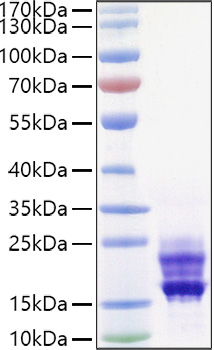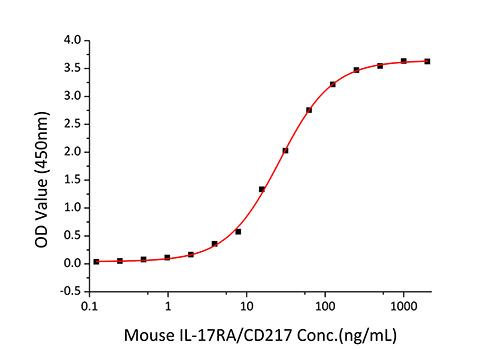Description
Recombinant Mouse IL-17A/CTLA-8 Protein
The Recombinant Mouse IL-17A/CTLA-8 Protein is a high-quality recombinant protein designed for murine biological research applications. This protein serves as an essential reagent in mouse model studies, comparative immunology research, and preclinical therapeutic evaluations, enabling scientists to investigate IL-17A/CTLA-8 biology and its relevance to human disease mechanisms through translational research approaches.
This product (SKU: RPCB0932) is produced using HEK293 cells and features a C-His tag for convenient detection and purification. The protein exhibits a calculated molecular weight of 15.82 kDa with an observed molecular weight of 16-24 kDa under denaturing conditions, achieving ≥ 90 % as determined by SDS-PAGE.. Functional bioactivity has been validated through rigorous quality control assays, confirming its suitability for demanding research applications.
Key Features
| High Purity by Affinity Chromatography | |
| Mammalian & Bacterial Expression Systems | |
| High lot-to-lot consistency via strict QC |
| Product Name: | Recombinant Mouse IL-17A/CTLA-8 Protein |
| SKU: | RPCB0932 |
| Size: | 10 μg , 20 μg , 50 μg , 100 μg |
| Reactivity: | Mouse |
| Synonyms: | Il17, Ctla8, IL-17, Ctla-8, IL17A, IL-17A |
| Tag: | C-His |
| Expression Host: | HEK293 cells |
| Calculated MW: | 15.82 kDa |
| Observed MW: | 16-24 kDa |
| Gene ID: | 16171 |
| Protein Description: | High quality, high purity and low endotoxin recombinant Recombinant Mouse IL-17A/CTLA-8 Protein (RPCB0932), tested reactivity in HEK293 cells and has been validated in SDS-PAGE.100% guaranteed. |
| Endotoxin: | < 0.1 EU/μg of the protein by LAL method. |
| Purity: | ≥ 90 % as determined by SDS-PAGE. |
| Formulation: | Lyophilized from a 0.22 μm filtered solution of PBS, pH 7.4. |
| Bio-Activity: | Measured by its binding ability in a functional ELISA. Immobilized Mouse IL-17A/CTLA-8 at 2 μg/mL (100 μL/well) can bind Mouse IL-17RA/CD217 with a linear range of 0.1-26 ng/mL.Measured by its ability to induce IL-6 secretion by NIH‑3T3 mouse embryonic fibroblast cells in the presense of 2 ng/mL TNFα(RPCB0855).The ED 50 for this effect is 0.26-1.04 ng/mL, corresponding to a specific activity of 9.62×10 5 ~3.85×10 6 units/mg. |
| Reconstitution: | Centrifuge the vial before opening. Reconstitute to a concentration of 0.1-0.5 mg/mL in sterile distilled water. Avoid vortex or vigorously pipetting the protein. For long term storage, it is recommended to add a carrier protein or stablizer (e.g. 0.1% BSA, 5% HSA, 10% FBS or 5% Trehalose), and aliquot the reconstituted protein solution to minimize free-thaw cycles. |
| Storage: | Store at -20℃.Store the lyophilized protein at -20℃ to -80 ℃ up to 1 year from the date of receipt. After reconstitution, the protein solution is stable at -20℃ for 3 months, at 2-8℃ for up to 1 week. |
IL17, also known as IL17a, is a cytokine that belongs to the IL-17 family. Cytokines are proteinaceous signaling compounds that are major mediators of the immune response. They control many different cellular functions including proliferation, differentiation, and cell survival/apoptosis but are also involved in several pathophysiological processes including viral infections and autoimmune diseases. Cytokines are synthesized under various stimuli by a variety of cells of both the innate (monocytes, macrophages, dendritic cells) and adaptive (T- and B-cells) immune systems. The IL-17 family of cytokines includes six members, IL-17/IL-17A, IL-17B, IL-17C, IL-17D, IL-17E/IL-25, and IL-17F, which are produced by multiple cell types. IL-17 regulates the activities of NF-kappaB and mitogen-activated protein kinases. This cytokine can stimulate the expression of IL6 and cyclooxygenase-2 (PTGS2/COX-2), as well as enhance the production of nitric oxide (NO). High levels of IL-17 are associated with several chronic inflammatory diseases including rheumatoid arthritis, psoriasis, and multiple sclerosis.








